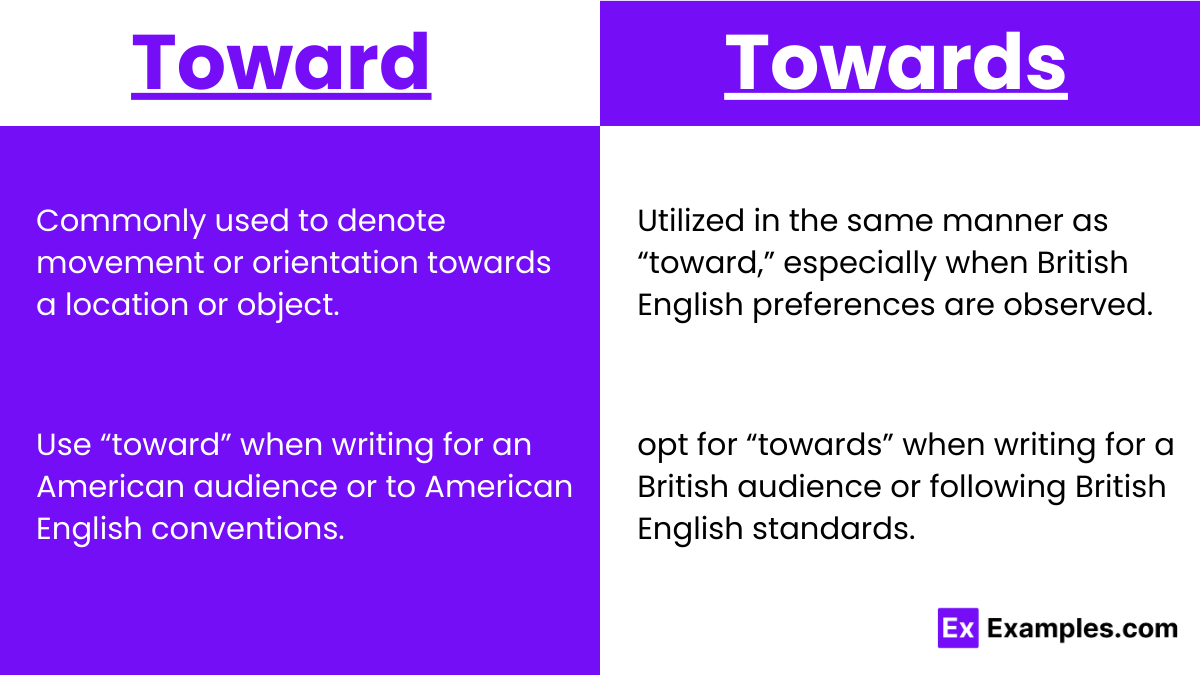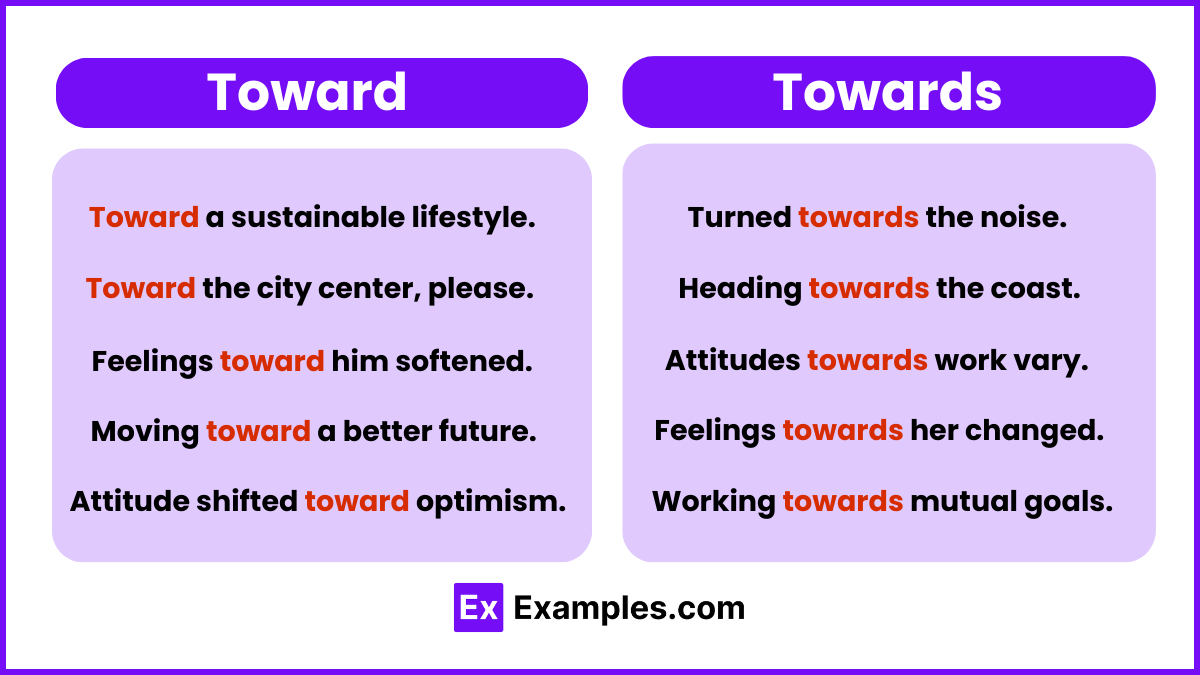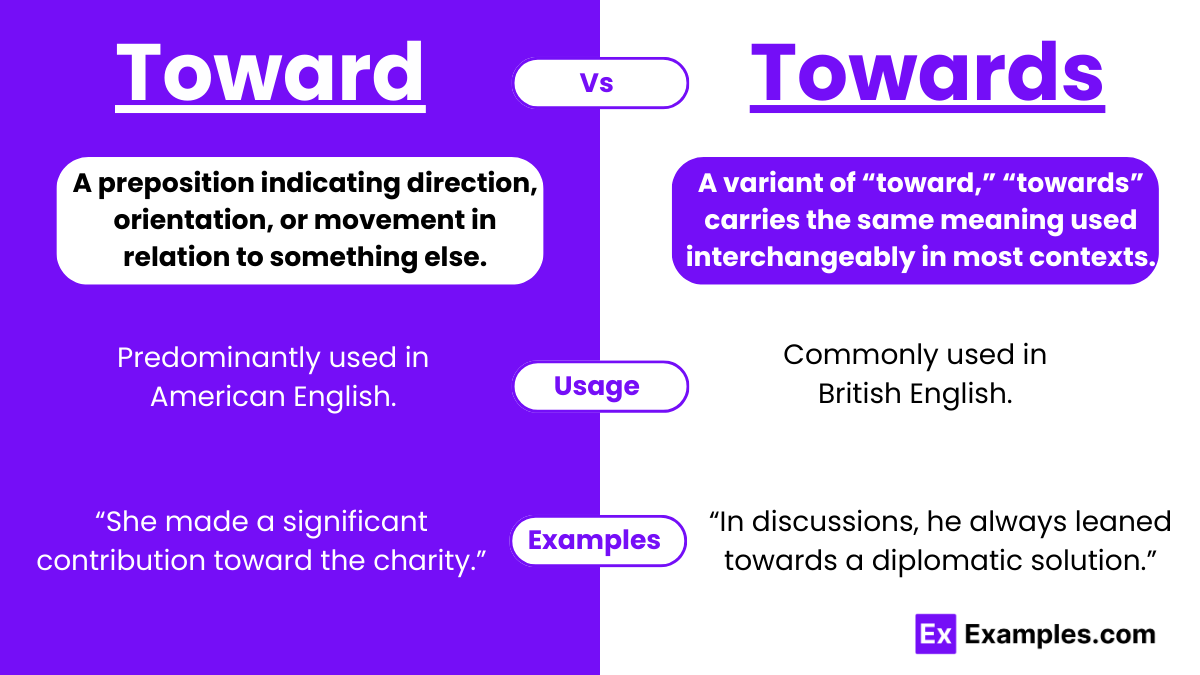Toward vs Towards – Meanings, Differences, Examples, Usage
These terms, seemingly identical in meaning, are differentiated primarily by regional usage—yet, they both indicate direction, orientation, or a movement in relation to something else. Whether it’s a physical movement towards a destination, a figurative step towards achieving a goal, or an attitudinal stance directed at someone or something, understanding the subtle distinctions between “toward” and “towards” enriches our grasp of English language intricacies. This article explores the meanings, pronunciations, and contextual applications of these terms, shedding light on their correct usage and regional preferences.
Toward and Towards – Meanings
- Toward: A preposition indicating direction, orientation, or movement in relation to something else. It is often associated with movement towards a particular direction, tendencies towards a state or condition, or attitudes and behaviors directed at individuals or concepts. The term suggests proximity and immediacy in actions or thoughts.
- Towards: Essentially a variant of “toward,” “towards” carries the same meanings and is used interchangeably in most contexts. The choice between the two often hinges on regional language conventions, with “towards” being the preferred form in British English.
Summary
“Toward” and “towards” serve as prepositions that denote direction, orientation, or movement relative to something. They also convey tendencies or attitudes directed at entities or individuals. The primary distinction lies in their regional usage: “toward” is favored in American English, while “towards” is more commonly used in British English. Despite these variations, the terms are functionally equivalent and are often used interchangeably across English dialects.
How to Pronounce Toward and Towards
- Toward: Pronounced as /təˈwɔrd/ (tuh-ward), this pronunciation emphasizes the second syllable, reflecting the term’s directional or orientationally nature.
- Towards: Pronounced as /təˈwɔrdz/ (tuh-wards), it is similar to “toward” but includes a slight “z” sound at the end, subtly accentuating its role in indicating direction or relation.
Differences between Toward and Towards
| Aspect | Toward | Towards |
|---|---|---|
| Regional Usage | Predominantly used in American English. | Commonly used in British English. |
| Context | Frequently found in formal and written contexts within the US. | Often used in both spoken and informal contexts in the UK. |
| Spelling | Characterized by its concise form, lacking the “s” at the end. | Distinguished by the additional “s” at the end. |
| Preference | Generally preferred in the United States, aligning with American English conventions. | Favored in the UK and other English-speaking regions outside the US, reflecting British English norms. |
| Flexibility | Less common in British English but understood and accepted. | Widely accepted in American English, especially in informal settings. |
How to Remember the Difference between Toward and Towards
Remembering the distinction can be simplified by associating the “s” in “towards” with “British spelling.” For American English contexts or audiences, “toward” is the go-to choice. Conversely, “towards” is more apt for British English settings or when adhering to British language standards.
When to Use Toward and Towards

Usage of Toward
- American English Contexts: Use “toward” when writing for an American audience or adhering to American English conventions. It’s the preferred form in the United States, making it suitable for formal writings, academic papers, and professional communications within American contexts.
- Formal Writing: In situations that call for a more formal tone, especially in American English, “toward” is often the preferred choice. This includes official documents, formal letters, and scholarly articles where a more standardized form of English is required.
- Describing Direction or Movement: When indicating movement in a specific direction or pointing out someone’s attitude or orientation towards something, “toward” is commonly used. It’s ideal for sentences that describe physical or figurative movement towards a goal, destination, or state.
- Figurative Expressions: In metaphors or idiomatic expressions that imply a progression or tendency towards something, such as “a step toward peace,” “toward” is typically used. It helps to convey the notion of advancing or moving closer to a particular condition or situation.
Usage of Towards
- British English Contexts: opt for “towards” when writing for a British audience or following British English standards. “Towards” is the form more commonly used in the UK, making it appropriate for texts intended for British publications, academic papers, and informal communication.
- Informal Writing: In less formal or more conversational contexts, especially within British English, “towards” is frequently chosen. This includes personal emails, blogs, and social media posts where a less formal tone is adopted.
- Expressing Relational or Attitudinal Stances: Use “towards” when expressing attitudes, feelings, or relational stances in contexts where British English is preferred. It’s suitable for phrases that describe how one relates to or feels about others, such as “her kindness towards strangers.”
- Idiomatic and Colloquial Usage: In idiomatic expressions and colloquial phrases that are more prevalent in British English, “towards” is often the term of choice. It fits naturally into phrases commonly used in the UK and other English-speaking regions outside the US, such as “leaning towards a decision” or “towards the end of the week.”
How to Use Toward and Towards
Using “Toward”
- Expressing Direction: Commonly used to denote movement or orientation towards a location or object.
- Example: “The bird flew toward the open window.”
- Relational Contexts: Used to describe one’s stance or relationship to various entities or concepts.
- Example: “His feelings toward the matter were ambivalent.”
Using “Towards”
- Similarly to “Toward”: Utilized in the same manner as “toward,” especially when British English preferences are observed.
- Example: “She extended a friendly gesture towards her new neighbors.”
- Idiomatic Usage: Found in certain expressions and idiomatic usages common to British English.
- Example: “All efforts towards peace are valuable.”
Toward and Towards – Examples

Examples of Toward
- “She made a significant contribution toward the charity.”
- “The explorer headed toward the uncharted territories with excitement.”
- “His cautious approach toward the negotiations proved beneficial.”
- “The leaves swirled toward the ground, caught in the autumn breeze.”
Examples of Towards
- “In discussions, he always leaned towards a diplomatic solution.”
- “The novel moves towards a surprising conclusion that leaves readers pondering.”
- “Her research is geared towards understanding complex ecosystems.”
- “Efforts towards conservation have increased in the community.”
Synonyms
| Term | Synonyms |
|---|---|
| Toward | In the direction of, towards, to |
| Towards | Toward, in the direction of, to |
Exercise
Fill in the blanks with either “toward” or “towards” to complete the sentences accurately.
- The project made significant strides _______ completion.
- Her research _______ ancient civilizations has garnered wide acclaim.
- The fund-raiser contributed a considerable amount _______ the hospital’s new wing.
- The trend in design is moving _______ sustainability and eco-friendliness.
- His compassionate approach _______ teaching inspired his students.
Answers
- toward
- toward
- toward
- towards
- towards
FAQ’S
Can Toward and Towards Be Used Interchangeably?
Yes, “toward” and “towards” are interchangeable, with “toward” more common in American English.
Do Americans Say Toward or Towards?
Americans predominantly use “toward,” while “towards” is more prevalent in British English.
What is the Difference Between Toward and Towards in Chicago Manual of Style?
The Chicago Manual of Style prefers “toward” without the “s” for consistency in American English writing.
What is an Example of To and Toward?
“To” indicates destination: “She walked to the store.” “Toward” suggests direction: “She walked toward the store.”
What is the Correct Use of Towards?
“Towards” is correctly used to indicate direction or orientation, similar to “toward,” especially in British English.
How Do You Use the Word Toward?
Use “toward” to indicate direction, attitude, or relation: “He moved toward the door.”


